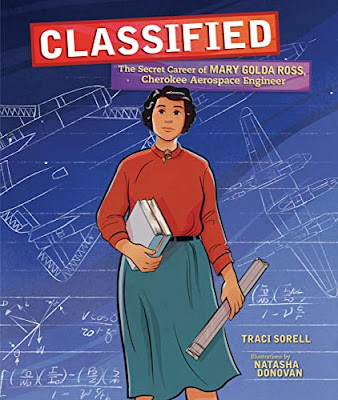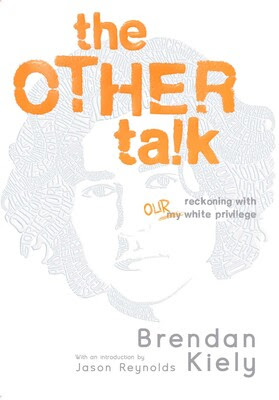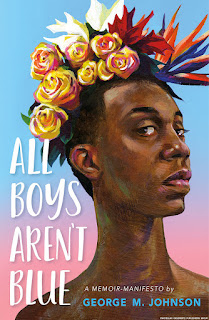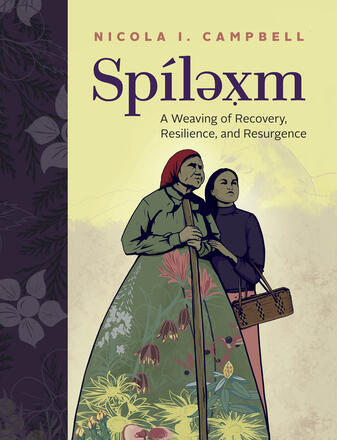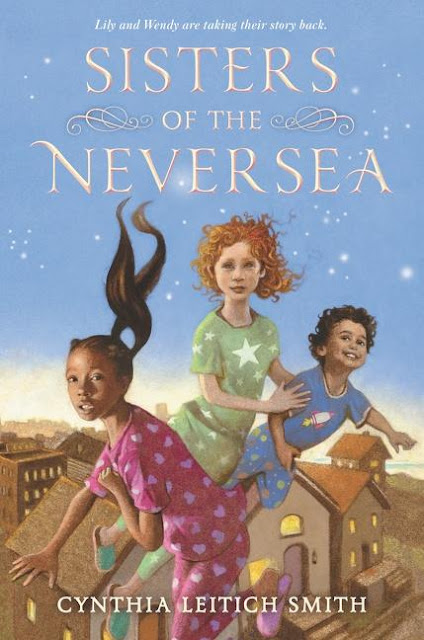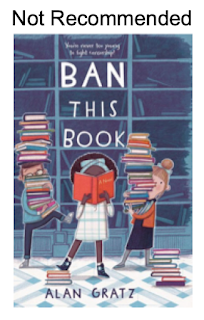- Home
- About AICL
- Contact
- Search
- Best Books
- Native Nonfiction
- Historical Fiction
- Subscribe
- "Not Recommended" books
- Who links to AICL?
- Are we "people of color"?
- Beta Readers
- Timeline: Foul Among the Good
- Photo Gallery: Native Writers & Illustrators
- Problematic Phrases
- Mexican American Studies
- Lecture/Workshop Fees
- Revised and Withdrawn
- Books that Reference Racist Classics
- The Red X on Book Covers
- Tips for Teachers: Developing Instructional Materi...
- Native? Or, not? A Resource List
- Resources: Boarding and Residential Schools
- Milestones: Indigenous Peoples in Children's Literature
- Banning of Native Voices/Books
Monday, November 29, 2021
Highly Recommended! CLASSIFIED:THE SECRET CAREER OF MARY GOLDA ROSS, CHEROKEE AEROSPACE ENGINEER, by Traci Sorell and Natasha Donovan
Sunday, November 28, 2021
Highly Recommended: THE OTHER TALK: RECKONING WITH OUR WHITE PRIVILEGE by Brendan Kiely
The facilitators were about to move on to their next exercise when a Native American woman in the audience stood up. She wanted to know why the racetrack model, why the entire workshop, did not include or allude to, in any way, Indigenous people in the United States. "This," she went on to explain, "is the kind of erasure we face every day."
Highly Recommended! LOOK GRANDMA! NI, ELISI! by Art Coulson; illustrated by Madelyn Goodnight
Saturday, November 27, 2021
Highly Recommended: JO JO MAKOONS, THE USED-TO-BE BEST FRIEND by Dawn Quigley; illustrations by Tara Audibert
Hello/Boozhoo—meet Jo Jo Makoons! Full of pride, joy, and plenty of humor, this first book in an all-new chapter book series by Dawn Quigley celebrates a spunky young Ojibwe girl who loves who she is.
Jo Jo Makoons Azure is a spirited seven-year-old who moves through the world a little differently than anyone else on her Ojibwe reservation. It always seems like her mom, her kokum (grandma), and her teacher have a lot to learn—about how good Jo Jo is at cleaning up, what makes a good rhyme, and what it means to be friendly.
Even though Jo Jo loves her #1 best friend Mimi (who is a cat), she’s worried that she needs to figure out how to make more friends. Because Fern, her best friend at school, may not want to be friends anymore…
Do you wanna know what mooshoom means? It means "grandpa" in the Michif language.
Try saying: "Jo Jo Makoons Azure nindizhinikaaz."
My girl, shots help you to be healthy. There are many sicknesses out there, and shots give good protection.
Friday, November 26, 2021
HIGHLY RECOMMENDED! THE CASE OF THE BURGLED BUNDLE: A MIGHTY MUSKRATS MYSTERY
Written by Michael Hutchinson (Misipawistik Cree Nation)
Published by Second Story Press
Publication Year 2021
Reviewed by Jean Mendoza
Review Status: Highly Recommended
Oh, the joys of a good mystery! This year saw publication of the third book in the middle-grade Mighty Muskrats series by Michael Hutchinson (Cree). This is a "Short and Sweet" review.*
The publisher, Second Story Press, says this about The Case of the Burgled Bundle:
The National Assembly of Cree Peoples has gathered together in the Windy Lake First Nation, home to the Mighty Muskrats -- cousins Chickadee, Atim, Otter, and Sam. But when the memory bundle, the center of a four-day-long ceremony, is taken, the four mystery-solving cousins set out to catch those responsible and help protect Windy Lakes reputation!... [P]rime suspect and long-time bully Pearl takes off to the city with her older brother and known troublemaker, Eddie. If they've brought the burgled bundle with them, the Mighty Muskrats fear it may be lost for good.
Here's my first reason of four to highly recommend this book: Authenticity. The author is Cree, and the setting is a fictional Cree community in what is currently known as Canada, with Cree characters who are believable, likable, and never stereotypical. The mystery confronting the young sleuths is plausible and meaningful in their community (though it can certainly resonate with non-Native readers). The resolution is surprising (to me, at least) but logical and satisfying in that context.
Second reason: Contemporary setting. As in the other two Mighty Muskrat books, current and ongoing issues for Indigenous people are central to the action. But it doesn't feel like like the author merely wants to make the story more timely or "more Indigenous," and he's not talking down to his readers, either. For example, from the very beginning, the reader gets a sense that unwelcome changes are afoot: without consulting all the leaders, someone with influence has changed the location of the important opening ceremony. It's a political decision that excludes most of the Cree people who expected to witness it. This developing situation especially concerns the Muskrats' Grandpa, who's an important recurring character.
Third reason: What's in the details. Hutchinson continues to embed factual information about Cree history and present-day life into his stories to convey the significance of what's going on. In the first chapter, for example, there's an especially poignant image of a middle-aged Cree man speaking in Cree to "an ancient woman," a frail elder seated beside him. He's telling her what he hears as he tries to listen in to the ceremony that was supposed to be public, but isn't. In one brief passage, readers see that Cree is a living language, that respect for elders is important, and that people are distressed but resourceful in response to being cut off from an important cultural event.
Fourth reason to highly recommend The Case of the Burgled Bundle: It's just a really engaging mystery.
A word of caution: I'm not Cree, and can't speak to the authenticity of the descriptions of the meeting of Cree nations or Cree traditions. If Cree readers of AICL see that I've missed something important, please let me know so I can note it here.
*A Short and Sweet rec is not an in-depth analysis. It is our strategy to tell you that we recommend a book we have read. We will definitely refer to it in book chapters and articles we write, and in presentations we do. Our Short and Sweet Recs include four reasons why we recommend the book.
Wednesday, November 24, 2021
Highly Recommended! Unspeakable: The Tulsa Race Massacre
"... a sensitive and powerful introduction to the Tulsa Race Massacre, helping young readers understand the events of the past so we can move toward a better future for all."
Monday, November 22, 2021
"Debbie, can you recommend some books about Thanksgiving?"
- Misrepresent historical facts
- Stereotype Wampanoag people
- Erase the Wampanoag people by failing to name them (defaulting to the general "Pilgrims and Indians" or "Pilgrims and Native Americans")
As you read it you can point out the parts of the story that show readers it is set in the present day. You could draw attention to the page that talks about how Josie's family worked all winter long, to get her ready to dance. I especially love this page, of a woman at a sewing machine:
Sunday, November 14, 2021
Highly Recommended: ALL BOYS AREN'T BLUE: A MEMOIR-MANIFESTO by George M. Johnson
In a series of personal essays, prominent journalist and LGBTQIA+ activist George M. Johnson explores his childhood, adolescence, and college years in New Jersey and Virginia. From the memories of getting his teeth kicked out by bullies at age five, to flea marketing with his loving grandmother, to his first sexual relationships, this young-adult memoir weaves together the trials and triumphs faced by Black queer boys.
Both a primer for teens eager to be allies as well as a reassuring testimony for young queer men of color, All Boys Aren't Blue covers topics such as gender identity, toxic masculinity, brotherhood, family, structural marginalization, consent, and Black joy. Johnson's emotionally frank style of writing will appeal directly to young adults.
... American Indians sharing food with the Pilgrims at the first Thanksgiving.
*takes deep breath*
What it doesn't show is that the Pilgrims stole the American Indians' food when they first arrived on the Mayflower, because they weren't prepared for winter.
We learned that Abraham Lincoln wasn't all he was cracked up to be. We learned about the Emancipation Proclamation, but also read some of the statements he made that weren't in the history books. The ones that were disparaging toward Black Americans and the fight for equality.
We learned that Lincoln had many thoughts that never seemed to make it into the pages of the history books.
He shares some of those statements made by Lincoln, including this one (p. 94):
"My paramount object in this struggle is to save the Union, and is not either to save or to destroy slavery. If I could save the Union without freeing any slave I would do it, and if I could save it by freeing all the slaves I would do it; and if I could save it by freeing some and leaving others alone, I would also do that."
Thursday, November 04, 2021
Update on AS AN OAK TREE GROWS (originally reviewed on Oct 12, 2014)
This inventive picture book relays the events of two hundred years from the unique perspective of a magnificent oak tree, showing how much the world can transform from a single vantage point. From 1775 to the present day, this fascinating framing device lets readers watch as human and animal populations shift and the landscape transitions from country to city. Methods of transportation, communication and energy use progress rapidly while other things hardly seem to change at all.
This engaging, eye-opening window into history is perfect for budding historians and nature enthusiasts alike, and the time-lapse quality of the detail-packed illustrations will draw readers in as they pore over each spread to spot the changes that come with each new era. A fact-filled poster is included to add to the fun.
The boy grew up and moved away. Farmers now lived here.
The boy no longer lived here. New people came and made their homes around the oak tree.
Sunday, October 31, 2021
Highly Recommended! Spílexm: A Weaving of Recovery, Resilience, and Resurgence, by Nicola I. Campbell
Spílexm: A Weaving of Recovery, Resilience, and Resurgence
If the hurt and grief we carry is a woven blanket, it is time to weave ourselves anew.
In the Nłeʔkepmxcín language, spíləx̣m are remembered stories, often shared over tea in the quiet hours between Elders. Rooted within the British Columbia landscape, and with an almost tactile representation of being on the land and water, Spíləx̣m explores resilience, reconnection, and narrative memory through stories.
Captivating and deeply moving, this story basket of memories tells one Indigenous woman’s journey of overcoming adversity and colonial trauma to find strength through creative works and traditional perspectives of healing, transformation, and resurgence.
Prairie LettersHer Blood is from SpetetkwMétisNłeʔkepmxcín LullabyLand TeachingsComing to my Sensessorrowyemít and merímstnthis body is a mountain, this body is the landResurgence
Friday, October 29, 2021
Highly Recommended! A Girl Called Echo, Volume 4: Road Allowance Era
Monday, October 25, 2021
Highly Recommended: SISTERS OF THE NEVERSEA by Cynthia Leitich Smith; cover art by Floyd Cooper
Today AICL is pleased to give a Short and Sweet Rec* to Cynthia Leitich Smith’s Sisters of the Neversea. We recommend you get it for your children, your classroom, or your library. Here’s the description:
Lily and Wendy have been best friends since they became stepsisters. But with their feuding parents planning to spend the summer apart, what will become of their family—and their friendship?
Little do they know that a mysterious boy has been watching them from the oak tree outside their window. A boy who intends to take them away from home for good, to an island of wild animals, Merfolk, Fairies, and kidnapped children, to a sea of merfolk, pirates, and a giant crocodile.
A boy who calls himself Peter Pan.
Four reasons why AICL recommends Sisters of the Neversea
First, the author is Native. Cynthia Leitich Smith is a citizen of the Muscogee Nation, telling us a story where the primary character is Muscogee Creek.
Second, Sisters of the Neversea shows readers who Native people are, for real. J.M. Barrie’s stories about Peter Pan have mis-informed generations of readers. His stories encourage others to play Indian in stereotypical ways, and the characters in his story that are meant to be Native (Tiger Lily) are straight-up stereotypes. We are nothing like the “Indians” in his stories. Smith’s take on Peter Pan pushes back on those stereotypes.
Third, Sisters of the Neversea includes Black Indians. Upon seeing Floyd Cooper's cover art, Smith writes that she thought "There you are!" With his art, she saw Lily as Black Muscogee. Later in the book, we meet Strings, a Black Seneca Indian from the Bronx.
Fourth, Smith's author’s note includes several questions that she poses about the Native people in Barrie’s stories. “How did they get there?” she asks, and “Why were they described in hurtful language?” are two of them. Teachers who use the book in the classroom can draw attention to those questions and encourage students to ask similar questions about Native characters in other books they read.
We hope you’ll get a copy ASAP, read it, and tell others to read it, too. When you’re at your local library, ask for it! If they don’t have it yet, ask them to order it.
-----
*A Short and Sweet Rec is not an in-depth analysis. It is our strategy to tell you that we recommend a book we have read. We will definitely refer to it in book chapters and articles we write, and in presentations we do. Our Short and Sweet Recs include four reasons why we recommend the book.
Thursday, October 07, 2021
NOT RECOMMENDED: Alan Gratz's BAN THIS BOOK
I've come to Dr. Reese's review of Indian Captive because of its appearance in Alan Gratz's 2017 novel Ban this Book. Gratz's story is about a schoolgirl standing up against book-banning in her grade-school library. At one point the avid young reader is suspended and grounded with nothing to read except Indian Captive. There is no commentary about the merits of the book, but it is mentioned several times, giving it a prominence above many of the books named in the story -- enough to send me to investigate. I can see no particular reason why this book was chosen for its role in the story (unless it's a very subtle indication that some books are not as good as others -- but it's quite a stretch to find that interpretation), other than mere carelessness by the author, indifference to the reasons a book may be offensive, or lack of awareness of the harm that books can perpetuate -- a naive belief in the magical goodness of every written word. It seems odd considering the theme of the story. Also odd given another theme of the story: good intentions that lead to bad consequences. As adults, we can understand the complexity of the real world, and the value of ambiguity in literature, but seeing that the issues raised by this one book's inclusion is not developed at all, and this in a novel for children, I can only see it as a flaw in an otherwise worthwhile book.
In Ban This Book by Alan Gratz, a fourth grader fights back when From the Mixed-Up Files of Mrs. Basil E. Frankweiler by E. L. Konigsburg is challenged by a well-meaning parent and taken off the shelves of her school library. Amy Anne is shy and soft-spoken, but don’t mess with her when it comes to her favorite book in the whole world. Amy Anne and her lieutenants wage a battle for the books that will make you laugh and pump your fists as they start a secret banned books locker library, make up ridiculous reasons to ban every single book in the library to make a point, and take a stand against censorship.
I like a lot of other books too, especially Island of the Blue Dolphins, Hatchet, My Side of the Mountain, Hattie Big Sky, The Sign of the Beaver, and Julie of the Wolves. Basically any story where the main character gets to live alone. Indian Captive is pretty great too, even though Mary Jemison has to live in an Indian village. But I would rather live with Indian kidnappers than live with my two stupid younger sisters.
"But what do I say? There's nothing bad about Little House on the Prairie."
She was right. But no--that was true about all the books. I had to think like Mrs. Spencer.
"They get malaria in that one," I said. "That's scary, right? And the settlers think it's because they ate bad watermelon! But that's not how you get malaria. That's deliberately misleading. That could make a kid think you get malaria from watermelons!"

